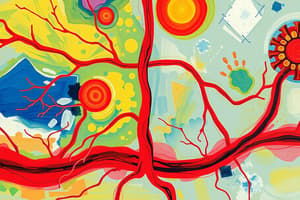Podcast
Questions and Answers
What is the definition of cervical lymph node?
What is the definition of cervical lymph node?
- masses of lymphatic tissue in the pharynx
- lymph nodes located under the armpit
- superficial lymph nodes located on the side of the neck (correct)
- drains right upper arm and right side of head and thorax
What are tonsils?
What are tonsils?
masses of lymphatic tissue in the pharynx
What does the right lymphatic duct drain?
What does the right lymphatic duct drain?
right upper arm and right side of head and thorax
What is the function of the thymus gland?
What is the function of the thymus gland?
Where are axillary lymph nodes located?
Where are axillary lymph nodes located?
What are Peyer's patches?
What are Peyer's patches?
What is the appendix?
What is the appendix?
What is produced by red bone marrow?
What is produced by red bone marrow?
What are the functions of the spleen?
What are the functions of the spleen?
What does the thoracic duct receive lymph from?
What does the thoracic duct receive lymph from?
What is the function of cistern chyli?
What is the function of cistern chyli?
Where are lumbar lymph nodes located?
Where are lumbar lymph nodes located?
What is the location of pelvic lymph nodes?
What is the location of pelvic lymph nodes?
What do inguinal lymph nodes receive?
What do inguinal lymph nodes receive?
Flashcards
Cervical lymph nodes
Cervical lymph nodes
Superficial nodes on the side of the neck that filter lymph fluid and support immune function.
Tonsils
Tonsils
Lymphatic tissue masses in the pharynx, trapping pathogens entering through the mouth and nose.
Right lymphatic duct
Right lymphatic duct
A vessel that drains lymph from the right upper arm, and the right side of the head and thorax into the venous system.
Thymus gland
Thymus gland
Signup and view all the flashcards
Axillary lymph nodes
Axillary lymph nodes
Signup and view all the flashcards
Peyer's patches
Peyer's patches
Signup and view all the flashcards
Appendix
Appendix
Signup and view all the flashcards
Red bone marrow
Red bone marrow
Signup and view all the flashcards
Spleen
Spleen
Signup and view all the flashcards
Thoracic duct
Thoracic duct
Signup and view all the flashcards
Cisterna chyli
Cisterna chyli
Signup and view all the flashcards
Lumbar lymph nodes
Lumbar lymph nodes
Signup and view all the flashcards
Inguinal lymph nodes
Inguinal lymph nodes
Signup and view all the flashcards
Study Notes
Lymphatic System Components
-
Cervical lymph nodes: Superficial nodes on the side of the neck that play a crucial role in filtering lymph fluid and supporting immune function.
-
Tonsils: Lymphatic tissue masses located in the pharynx, essential for trapping pathogens entering through the mouth and nose.
-
Right lymphatic duct: A vessel that drains lymph from the right upper arm and the right side of the head and thorax into the venous system.
-
Thymus gland: A mediastinal lymphoid organ responsible for maturing T cells, which are vital for the adaptive immune response.
-
Axillary lymph nodes: Nodes situated under the armpit that filter lymph from the breast, upper limbs, and parts of the thorax.
-
Peyer's patches: Aggregations of lymphatic tissue found in the submucosa of the small intestine; they monitor intestinal bacteria and prevent the growth of pathogenic bacteria.
-
Appendix: A small, blind pouch connected to the cecum, believed to play a role in gut immunity.
-
Red bone marrow: The site of hematopoiesis where red blood cells, white blood cells, and platelets are produced.
-
Spleen: An organ that generates lymphocytes, filters blood, stores blood cells, and helps in the destruction of aging blood cells.
-
Thoracic duct: A major lymph vessel that collects lymph from the left side of the head, neck, chest, abdomen, left arm, and lower limbs, returning it to the bloodstream.
-
Cistern chyli: An enlarged area on the thoracic duct, serving as a storage site for lymph before it enters the venous system.
-
Lumbar lymph nodes: Nodes situated in front of the lumbar vertebrae that receive lymph drainage from the gastrointestinal tract and abdominal organs.
-
Pelvic lymph nodes: Located in the pelvic region, these nodes are responsible for transporting fluid, nutrients, and waste products between tissues and the bloodstream.
-
Inguinal lymph nodes: Nodes that mainly receive lymph drainage from the lower extremities, crucial in the immune response and fluid balance.
Studying That Suits You
Use AI to generate personalized quizzes and flashcards to suit your learning preferences.




